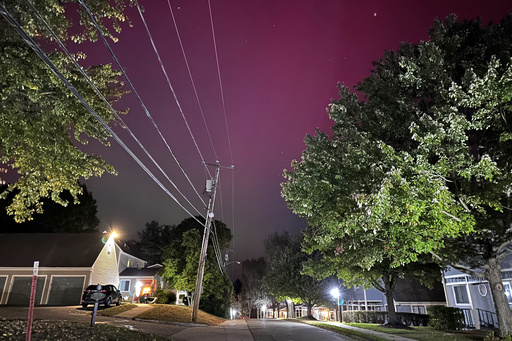A recent series of powerful solar storms has resulted in breathtaking displays of colorful auroras further south than usual, with sightings reported in areas such as Germany, the United Kingdom, New England, and even New York City.
Shawn Dahl, a forecaster at the Space Weather Prediction Center under the National Oceanic and Atmospheric Administration (NOAA), remarked on the impressive nature of these displays, noting that sightings of the northern lights have been reported as far south as New Mexico.
Fortunately, there have been no immediate reports of disturbances to electrical power grids or communication systems.
Earlier this week, NOAA issued a severe geomagnetic storm alert following a solar event identified on Wednesday. These storms can enhance the likelihood of auroras and may temporarily interfere with power and radio communications.
The current forecast from NOAA indicates that elevated activity levels are expected to continue, although the likelihood of additional auroras appearing further south of Canada and the northern Plains is minimal.
The phenomenon of northern lights arises when the sun emits more than just heat and light — it releases energy and charged particles known as the solar wind. Sometimes, this solar wind can intensify into a storm when the sun releases significant bursts of energy termed coronal mass ejections, leading to solar storms or geomagnetic storms, according to NOAA.
While Earth’s magnetic field provides a protective barrier against most of this energy, charged particles can travel along the magnetic field lines toward the poles, entering our atmosphere.
The interaction between these particles and atmospheric gases can create visible light, with nitrogen producing blue and purple hues, while oxygen gives off green and red colors.
Dahl pointed out that this particular solar storm resulted in a remarkably bright display due to the favorable alignment of the storm’s magnetic orientation with that of Earth. “We maintained a strong connection,” he mentioned.
In answering why there has been an uptick in solar storms lately, astronomers explain that solar activity follows an 11-year cycle, currently believed to be on the upswing, known as solar maximum.
In May, the sun unleashed its most powerful flare in nearly twenty years, occurring shortly after a wave of severe solar storms impacted Earth and produced auroras in unexpected regions of the Northern Hemisphere.
More solar activity is anticipated, as Dahl mentioned that we remain “in the grip” of the solar maximum until early 2026, suggesting more exciting experiences similar to those observed recently.
For those wishing to catch a glimpse of the northern lights, NOAA recommends escaping the brightness of urban areas.
The optimal viewing time is generally an hour or two before or after midnight, with the agency noting that the best occasions to observe the auroras are around the spring and fall equinoxes, due to the interaction between solar wind and Earth’s magnetic field.
